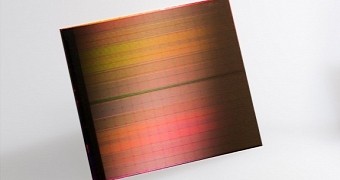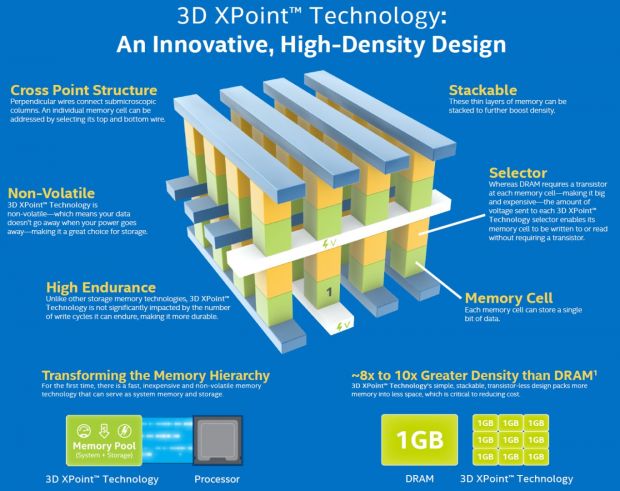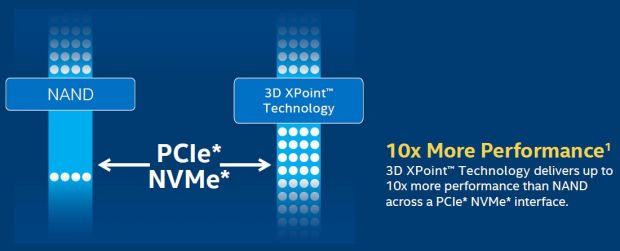Intel and Micron announced Tuesday a brand-new, if not revolutionary memory type called 3DXPoint. The new memory type will combine the advantages of DRAM with NAND flash and promises storage solutions performance well higher of what we have today.
The new 3DXPoint memory is apparently built by Intel and Micron in tandem and it is the first all-new completely built from ground-up memory technology that supersedes the NAND flash first introduced in the eighties. Yes, folks, we still work on computer technology that's still fundamentally the same as the one used thirty years ago.
The 3D XPoint is a non-volatile type of memory, having eight to ten times more density than DRAM and performance values tens or even hundreds of times faster than NAND flash. It seems that although 3D XPoint combines the advantages of the NAND flash and DRAM, it won't replace them entirely as it doesn't excel in performance against DRAM or storage capacity compared to current 3D NANDs.
Being in an experimental phase with the core mechanism working as it should, it will be able to completely overcome the two memory technologies when reaching maturity.
It's better than NAND and DRAM but not with SATA and PCIe 3.0
The 3D XPoint was developed since 2012, which is in total infancy as of now, in terms of memory technology average lifespan. Intel and Micron hope that while the new memory technology moves forward and matures, the final performance values of the 3D XPoint will become obvious.
The architecture of 3D XPoint memory is called cross point array and it involves perpendicular conductors connecting 128 billion densely packed memory cells. Each memory cell stores a single bit of data, therefore we get a chip of 128Gb. Memory cells are accessed and written or read by varying the amount of voltage sent to each selector. This way there is no need for transistors, increasing capacity and keeping the same average costs intact. Keeping cell sizes small and fast switching selectors with low latency cross point array the cell will be able to switch states faster than any existing memories today.
Intel and Micron also claim that the new architecture can be scaled both horizontally and vertically since it's based on a cell stacking feature that will allow more and more cells once new process technology will allow more die shrinking.
The two companies believe the new 3D XPoint technology will speed up dramatically consumer and enterprise devices and help build new supercomputers. More so, it seems D XPoint technology to more quickly identify fraud detection patterns in financial transactions and help track diseases in medical research and help create faster genetic analysis.
The memory advances are made, what we need is next-gen interface
Although current SATA and PCIe interfaces will slow down the new storage media, newer interfaces like the PCIe NVMe will deliver a 10-time-increased 3D XPoint's performance. To fully exploit the performance of 3D XPoint, a new PCIe interface should be developed, like the PCI Express 4.0 or even the rumored, optically connected PCIe 5.0 that offers just enough speed for the switch selectors and transfer of read/write data to go beyond the bottleneck limits of existing copper pins.
Intel plans to send the first 3D XPoint-based products in 2016 and plans to build the first 300mm wafers in tandem with building current-gen 3D NAND flash chips, so the availability of the new tech will be rather limited. Intel and Micron do not plan at the moment to license the new tech so it will remain a very exclusivist property for the foreseeable future.
Now it makes much more sense why the U.S. authorities blocked any attempt of Tsinghua Unigroup to touch Micron. They were keeping precious things under their wrap, and for the Chinese to touch such futuristic technologies would be inconceivable.

 14 DAY TRIAL //
14 DAY TRIAL // 




